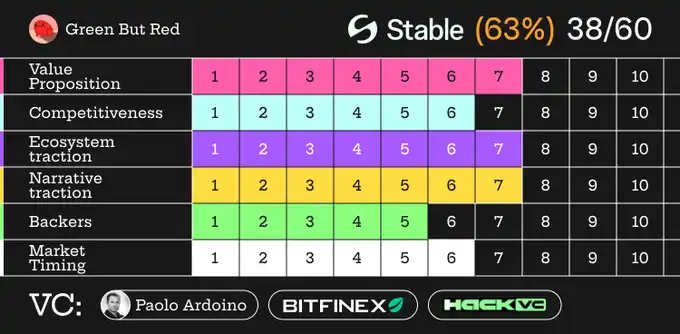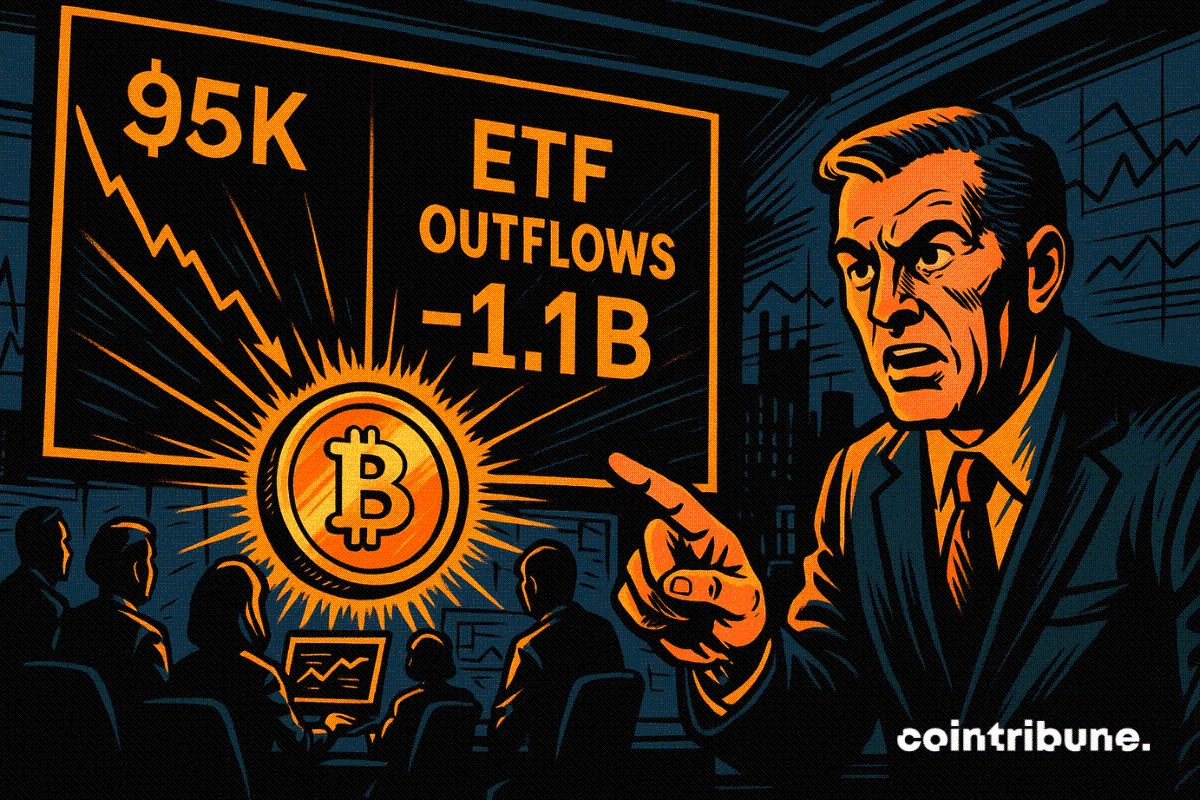Is 80% Just Hype? Six Major Red Lines Reveal the True Intentions of Stable
It appears to be an infrastructure upgrade, but in essence, it's an early insider-friendly issuance.
Original Title: Stable Investment Analysis (in 6 Red Flags)
Original Author: @green_but_red
Translation: Peggy, BlockBeats
Editor's Note: Recently, Stable completed two rounds of sizable activities in a short period, with the first phase quota of 825 million USD being snapped up quickly, and the second phase qualified subscription amount exceeding 1.1 billions USD, drawing significant attention from the industry.
However, behind these impressive numbers, there are backgrounds worth clarifying: the project is driven by key figures from Tether, with USDT as the native asset forming a natural strong bond; quotas are highly concentrated among early institutions and insiders; and the time gap between the implementation of the "GENIUS Act" and the project's acceleration is overly tight.
This article attempts to present a more complete picture beyond the hype: what infrastructure problem is it really solving? Who benefits early on? Where are the risks? And why is this issuance worth a closer look beyond its surface.
The following is the translated original text.
TL;DR: Basic Situation
The Stable project swept the field in its first phase with a TVL of 825 million USD, completing fundraising in just 20 minutes, and recently launched a public testnet. But behind this frenzy, there are some uncomfortable issues: risks from high stablecoin concentration, insiders taking positions in advance, and whether the project is really solving payment problems or just creating a new batch of "bag holders." Below is an as-honest-as-possible interpretation:
What is the project?
A Layer 1 with USDT as its native asset, strongly supported by Tether insiders—but who are the real beneficiaries?
Key Data:
Raised 28 million USD in the seed round, quota scale of 825 million USD (snapped up in 20 minutes—was it too fast?); public testnet is live, but mainnet launch is still weeks away, while early insiders are already preparing to exit.
Core Narrative:
Stablecoins need new payment rails, but Stable's current design benefits those who got in early, while retail investors are clearly at a "disadvantageous position."

Value Proposition: 7/10
What problem is it actually solving:
Using USDT as gas does indeed save the hassle of swapping between two tokens, which is reasonable. But a blunt question: do users really care about this, or are they mainly chasing high mining yields?
Honest Assessment:
It does solve a real problem (gas fees for stablecoin transfers), but on Solana/Polygon, a single transfer of 100,000 USD already costs less than 1 USD. Tether's USDT0 cross-chain mechanism can achieve similar effects without the need for a new L1. The so-called "pain point" may not be as big as the marketing claims.
The truly valuable part:
It looks more like payment infrastructure for institutions, rather than a payment innovation for retail users.
But the current structure is: retail speculates, institutions take the protocol layer value.
Six Major Red Flags
Red Flag 1: Solving for the Sake of Solving, the Problem Isn't That Painful
USDT transfers are already very cheap now, with fees on @Solana generally below 1 USD. So why launch a brand new L1 just to reduce fees by another 10–20%?
Competitive Landscape: 6/10
The real competitive environment:
@Plasma ($XPL): Similar narrative, smaller fundraising scale, but different tokenomics design
@Solana + $USDT: USDT daily trading volume has reached the 5 billions USD level, and usage friction is already very low
@LayerZero_Core / $USDT0: USDT circulation can be achieved through existing cross-chain infrastructure, no need to build a new chain
Why Stable is not unshakable:
First-mover advantage does exist, but can be copied within 6 months
If alternatives are equally good, network effects are hard to sustain
Validator concentration (only about thirty main validators), which means obvious centralization risk
Red Flag 2: Timing Is Too "Coincidental"
"GENIUS Act" passed (June 2025)
→ @Tether_to suddenly accelerates the new L1 in August 2025
→ In October 2025, the quota is oversubscribed by 39 times.
This series of time points looks like a pre-designed coordinated move.
Growth & Hype: 7/10
825 million USD quota: Let's look at reality calmly
Snapped up in 20 minutes (more like FOMO than organic demand), with a high probability that 95% of the funds came from whales and insiders who got the information in advance. Because the quota was filled so quickly, there was almost no FOMO phase left for retail. Funds are locked until mainnet launch and cannot exit early.
What these phenomena actually indicate:
Institutional interest is real, but funds and chips are highly concentrated. Early insiders are likely to sell at mainnet launch, while retail is likely to enter at the emotional peak.
Public testnet activity (mediocre):
Discord subscribers 600+ (not impressive for a new L1 project), developer activity remains to be seen (testnet has only been live for two weeks). Real applications will only roll out after mainnet launch, and there is no on-chain transaction volume data to reference yet.
Red Flag 3: Structural Design
Funds are locked in the vault before mainnet launch and can only be unlocked when withdrawals are allowed.
This is a typical "unlock—dump" structure:
Early participants naturally become the most motivated sellers the moment they can claim their tokens.
Narrative & Story: 7/10
Why the story is appealing:
Clear regulatory framework ("GENIUS Act") creates a sense of urgency—"get in now or miss out"
Backed by @Tether_to, seemingly with institutional-level endorsement
There is objectively a gap in payment infrastructure
From a chronological perspective, everything seems to "fall into place"
The loophole in this narrative:
"USDT as gas" is not a disruptive innovation, just a gradual improvement. The popularity of stablecoins does not depend on building a new L1, and the real beneficiaries are protocol insiders, not ordinary users.
The story told to retail is still the same old one: "Hold stablecoins and earn extra yield," a classic trap proven in the last cycle
Red Flag 4: The Regulatory Story Is a Bit "Too Perfect"
As soon as the "GENIUS Act" passes, a "perfectly timed, unbeatable narrative" USDT L1 appears? Overall, it feels more like a pre-structured deal, just waiting for regulation to land so it can be wrapped in a layer of compliance.
Supporters: 5/10
The real beneficiaries:
@paoloardoino (Tether CEO): If Stable becomes the mainstream payment rail, he is the most direct beneficiary
@bitfinex: As a liquidity provider, can continuously profit from trading fees
Franklin Templeton: Strategic investor deploying on emerging infrastructure
Early seed investors: Positioned before mainnet launch, waiting to sell at the mainnet's emotional peak
Those who may get hurt:
Retail who bought into the vault, late mainnet participants, and ordinary users who think this is a "free payment" solution (they will pay the price elsewhere)
Red Flag 5: Conflict of Interest
Tether's CEO is strongly supporting an infrastructure with $USDT as the native token—the more USDT is used, the more he earns.
Such an obvious conflict of interest, yet it hasn't been publicly highlighted as a "major conflict."
Red Flag 6: Insiders Taking Positions in Advance
28 million USD seed round, most likely secured a huge quota. The project is already full of insider funds
The moment the public mainnet launches → insiders are almost guaranteed to dump their chips to retail FOMO
Market Timing: 6/10
Why launch now?
The "GENIUS Act" provides a regulatory "umbrella," and the market sentiment towards stablecoins is generally positive. But the timing of all this is just "a bit too coincidental"
Potential problems:
Regulatory winds reverse (the "GENIUS Act" itself faces opposition); competing stablecoin L1s launch faster and steal the narrative; real trading volume after mainnet launch falls short of expectations; insiders dumping causes token price to crash
To put it more bluntly:
The rhythm of this issuance is: "We wait for regulatory certainty, then immediately rush into the market." This is either textbook-level execution or a highly coordinated "well-orchestrated" plan.
Summary
Final Score: 38/60 (63%)
Bullish logic (still valid):
Global payment infrastructure is indeed very important; a network with USDT as its native asset is likely to become some kind of industry standard in the future; positioning early in infrastructure can indeed capture long-term value; from the information disclosed so far, the mainnet's technical execution seems reliable
Bearish logic (also true):
Before retail enters, insiders have already taken large positions in advance; the problem being solved has already been "mostly solved" by existing solutions; the token structure is extremely favorable to early participants but unfavorable to those buying in on mainnet; if the "GENIUS Act" faces challenges, the project faces regulatory uncertainty
The uncomfortable truth:
This may actually be a "pretty good" infrastructure-level project, but its distribution and issuance mechanism are clearly heavily tilted towards insiders: early participants are most motivated to sell at the mainnet FOMO peak, while retail usually buys in at the height of emotion.
This is a classic structure.
Conclusion:
Stable has real technical highlights and does target real existing problems.
But its timing, mechanism, and insider positioning all highly fit the standard paradigm of—
"Looks like an infrastructure upgrade, but is essentially an insider-friendly early issuance."
This doesn't mean the project is necessarily bad,
It just means: the risk is extremely asymmetric.
Be sure to think carefully: which side of the timeline are you on now?
You might notice a detail:
The institutional quota was snapped up in 20 minutes,
While retail is still asking "What is Stable?"
The time gap between insiders and retail entering,
Is often where most losses occur.
Disclaimer: The content of this article solely reflects the author's opinion and does not represent the platform in any capacity. This article is not intended to serve as a reference for making investment decisions.
You may also like
Yala Faces Turmoil as Stability Falters Dramatically
In Brief Yala experienced a dramatic 52.9% decline, challenging its stability. Liquidity management emerged as a critical vulnerability in stablecoins. Investor skepticism deepened despite major fund support.

US Bitcoin ETFs Log $1.1B Weekly Outflows as BTC Slides Toward $95K

ECB Warns Rapid Stablecoin Growth Could Force Rethink of Eurozone Monetary Policy

Hong Kong Pilot Marks Breakthrough Moment for Regulated Fund Tokenization

